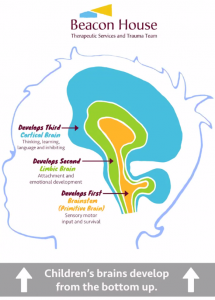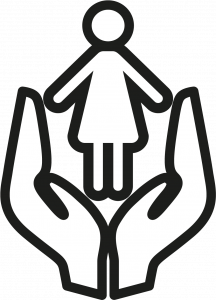‘Trauma refers to the way that some distressing events are so extreme or intense that they overwhelm a person’s ability to cope, resulting in lasting negative impact.’(UK Trauma Council)
The government published guidance in a ‘working definition of trauma informed practice’, November 2022:
Trauma results from an event, series of events, or set of circumstances that is experienced by an individual as harmful or life threatening. While unique to the individual, generally the experience of trauma can cause lasting adverse effects, limiting the ability to function and achieve mental, physical, social, emotional or spiritual well-being.
Examples of trauma might be abuse, neglect, war, national disasters or a serious accident. It might also be discrimination and may impact on the child if the event happens directly to them or if they witness if happening to someone else.
Many people think of trauma as a single event but early childhood trauma can occur over time or be a repeated event that can have a significant impact on both emotional health and neurological development.
Neurological Development

85% of our brain has developed by the age of 2. Babies are born with around 100 billion specialist cells(neurons) . These then link through pathways (synapsis). They specialise in response to chemical signals, starting at the primitive section of the brain and then moving upwards.
- Getting a good response strengthens the pathways eg. parent responding to crying.
- An abusive or negative response, strengthens different pathways. This means a future response to nurturing, may be impaired.
- If appropriate exposure to experiences doesn’t happen, pathways are discarded (synaptic pruning).
Experiencing or witnessing traumatic events can result in adaptations in brain structure and brain chemistry (increase in cortisol and adrenaline) alongside impacting on emotional, social and cognitive development. As a result, childhood trauma is associated with mental health problems, difficulties in personal and social relationships and an increased risk in new stressful experiences.
For further information on brain development and giving positive brain building experiences to children, please see https://learning.nspcc.org.uk/child-health-development/childhood-trauma-brain-development
Developmental (Complex) Trauma
Developmental Trauma is the term used to describe the impact of early, repeated trauma and loss which happens within the child’s important relationships, and usually early in life. A study by the NSPCC found that nearly 1 in 5 children suffer some form of abuse or neglect. Abuse and neglect are commonly described as complex traumas (although not all cases will reach a definitional threshold). Repeated trauma can result in the child developing a range of coping strategies that help them react to threat but results in a range of difficulties over time.
See our page, ‘Trauma Informed Practice’ for more information on how trauma can impact on behaviour.
ACES (Adverse Childhood Experiences)
ACEs are adverse childhood experiences that harm children’s developing brains and lead to changing how they respond to stress and damaging their immune systems so profoundly that the effects show up decades later. ACEs can lead to chronic disease, depression and other mental illness, violence and being a victim of violence and financial and social problems.
“ACEs” comes from the CDC-Kaiser Adverse Childhood Experiences Study. One of the interesting elements of this study is that the 17,000 ACE Study participants were mostly white, middle- and upper-middle class, college-educated, and all had jobs and good health care.
The researchers measured ten different types of ACES and they made significant discoveries:
- 67% of adults have experienced at least one ACE in their life.
- ACES cause onset of chronic disease such as cancer, heart disease and mental illness
- If you have one ACE, you are 87% likely to have more.
- People with high ACE scores are more likely to be violent, to have more marriages, more broken bones, more drug prescriptions, more depression, and more autoimmune diseases. People with an ACE score of 6 or higher are at risk of their lifespan being shortened by 20 years.
- ACEs are responsible for a large percentage of workplace absenteeism, and for costs in health care, emergency response, mental health and criminal justice.
- Regardless of which ACES a person has, the harmful consequences are the same. The brain cannot distinguish one type of toxic stress from another; it’s all toxic stress, with the same impact.
Toxic Stress
Neuroscience has found that in the absence of protective factors, toxic stress damages children’s brains. When stressful situations occur, we naturally respond with a FIGHT, FLIGHT OR FREEZE mode (use of the primitive brain). Toxic stress occurs when events or environments that are threatening or harmful, happen regularly which then causes an overload of stress hormones such as cortisol and adrenaline. Over time, as additional stress or trauma is experienced, the body has difficulty returning to a normal state and the function and structure of the brain are harmed.
Children and adults who have experienced childhood trauma may respond more quickly and strongly to events that would not affect those without ACEs. Traumatic events may result in heightened anxiety, hypervigilance, grief, negative self-image, defiant and aggressive behaviours, problems with concentration, sensory processing difficulties, sleep problems and emotional dysregulation.
However, it is important to say that traumatic stress is not necessarily an inevitable consequence of a traumatic event itself – traumatic stress is linked to the individual resources and ways they use to cope with it. Every child is unique and copes with events differently, therefore it is very subjective.
Protective Factors
Protective factors are conditions that are present in families or communities, that increase the well-being of children and families and help them develop resilience, despite exposure to ACES.
The American Trauma Society, gives the following examples of protective factors:
- Supportive family environment
- Nurturing parenting skills
- Stable family relationships
- Household rules and monitoring of the child
- Parental employment
- Adequate housing
- Access to health care and social services
- Caring adults outside family who can serve as role models or mentors
- Communities that support parents and take responsibility for preventing abuse
As professionals working with children and their families, we can help put protective factors in place.
See our page, ‘Trauma Informed Practice’ for more information on developing a safe, supportive environment and helping to put protective factors in place.

References:
- Attachment and Trauma Network, Inc
- Pacesconnection.com
- beaconhouse.org.uk
- UK Trauma Council
- Gov.uk – Guidance: Working Definition of Trauma-Informed Practice
- NSPCC.org.uk
- American Trauma Society

